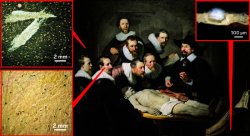Professor’s Crystal Structure appeared in C
The structure is used to describe metal soap formation.
Posted in: Chemistry, Research News

The research of Dr. Jaclyn Catalano, in the Chemistry and Biochemistry Department and her collaborators at the Metropolitan Museum of Art and the University of Delaware, was used to describe metal soap formation in the May 23rd issue of Chemical and Engineering (C&E) News. Soap formation in traditional oil paintings occurs when heavy-metal-containing pigments, such as lead white and lead tin yellow type react with fatty acids in the binding medium. These soaps may form aggregates that can be 100–200 μm in diameter, which swell and protrude through the paint surface, resulting in the degradation of the paint film and damage to the integrity of the artwork. The problem of metal soap formation that is affecting hundreds of works of art from the 15-20th centuries. Dr. Jaclyn Catalano’s postdoctoral work at the Metropolitan Museum of Art and the University of Delaware and work she is continuing at Montclair State University is related to understanding the structure and mechanism of soap formation, in order to prevent soap formation and conserve these works of art. Dr. Catalano and her collaborators used spectroscopy and x-ray crystallography to obtain a structure of lead palmitate and lead stearate, which are commonly found in soap inclusions, this work is described in the Dalton Transactions publication below.
